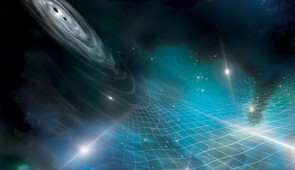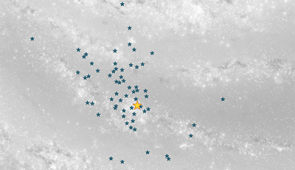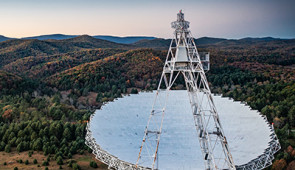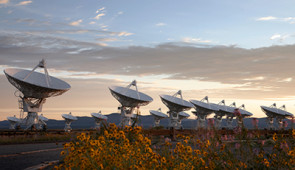
Exotic stars enable scientists to tune into the hum of a cosmic symphony
Hum holds evidence of record-breaking gravitational waves
- Link to: Northwestern Now Story
- International collaboration releases 15-year dataset collected from galaxy-sized gravitational wave detector
- From the data, astrophysicists observed evidence of the longest, slowest gravitational waves ever recorded, overlapping to produce a background ‘hum’
- Some of the waves are so long and slow that it takes 15 years for one wave cycle to fully pass through Earth
- Experts hypothesize that supermassive black hole binary systems or exotic physics might be responsible for the waves
EVANSTON, Ill. — An international team of researchers, including Northwestern University astrophysicists, have used a galaxy-sized tool composed of 68 dead stars to sense the longest, slowest gravitational waves ever detected.
With lengths equivalent to 15 light-years, some of the waves are so long and slow that it takes 15 years for each individual wave cycle to fully pass through Earth. Together, these gravitational wave signals overlap, like voices in a crowd or instruments in an orchestra, producing an overall cosmic “hum” that imprints a pattern in the data.
The record-breaking gravitational-wave signal was observed in 15 years of data acquired by the North American Nanohertz Observatory for Gravitational Waves (NANOGrav) Physics Frontiers Center (PFC), a collaboration of nearly 200 scientists from the United States and Canada who use a type of exotic neutron star, called pulsars, to search for gravitational waves.
While earlier results from NANOGrav uncovered an enigmatic timing signal common to all the pulsars they observed, the signal was too faint for researchers to determine its origin. The 15-year dataset release demonstrates that the signal is consistent with slowly undulating gravitational waves passing through our galaxy. By further investigating these monster waves, astrophysicists could potentially learn more about how the universe evolved on the largest scales, how often galaxies collide and what drives black holes to merge.
A suite of four papers detailing the new discovery will be published on June 28 in The Astrophysical Journal Letters. Northwestern postdoctoral fellow Caitlin Witt co-authored all four papers as well as a complementary set of papers now available on ArXiv. A public lecture will air on YouTube at 1 p.m. EDT (U.S.) on Thursday, June 29.
“We think the most likely source of this type of signal is a population of supermassive black hole binaries, but we want to be careful not to assume that,” Witt said. “Scientists also have theorized that it could be remnants from the Big Bang or cosmic strings generating this signal. The publication of these studies is not the end of our research but the beginning. It’s the starting gun, marking the beginning of trying to understand this new population of gravitational waves.”
Witt is the inaugural CIERA-Adler Postdoctoral Fellow at Northwestern’s Center for Interdisciplinary Exploration and Research in Astrophysics (CIERA) and the Adler Planetarium. Luke Kelley, an astrophysicist at the University of California, Berkeley and former postdoctoral fellow at CIERA, is chair of NANOGrav’s astrophysics group.
The NANOGrav Collaboration is led by Stephen Taylor of Vanderbilt University, Maura McLaughlin of West Virginia University and Xavier Siemens of Oregon State University.
Tracking squeezed space-time with cosmic timepieces
In 2016, an international collaboration including Northwestern professor Vicky Kalogera, who was a leading astrophysicist on the team, used the Laser Interferometer Gravitational-Wave Observatory (LIGO) to first detect gravitational waves from the merger of two stellar-mass black holes, which resulted in obvious, short-lived ripples in space-time. But the newly discovered population of gravitational waves is too big and change much too slowly for Earth-based equipment like LIGO to detect. Even when NASA and the European Space Agency launch LISA (a space-based gravitational wave detector for which Northwestern professor Shane Larson is a member of the science collaboration) in the early 2030s, it still will not be able to detect such enormous waves.
To overcome this obstacle, NANOGrav leverages pulsars, a type of rapidly rotating neutron star born in the supernova explosion of a massive star at the end of its life. Just like a lighthouse, a pulsar spins rapidly, sweeping radio waves through space, so they appear to “pulse” when viewed from Earth. The fastest of these objects, called millisecond pulsars, spin hundreds of times per second.
“Because pulsars spin so stably, we see little flashes of light that tick like a clock,” Witt said. “We watch that light with ground-based radio telescopes. If the clock ticks arrive either a little bit early or a little bit late, this is a sign that it could have been affected by a gravitational wave.”
By looking across the entire sky, Witt and the NANOGrav team search for specific patterns from all pulsars together. According to Einstein’s theory of general relativity, supermassive black hole binaries should emit gravitational waves that literally stretch and squeeze (or strain) space-time on their way to Earth. Warped space-time effects pulsars’ pulses in such a way that indicates monstrous but elusive gravitational waves.
“It is thrilling to be at the doorstep of multi-band gravitational-wave astronomy just less than a decade since the opening of the new observational field,” said Kalogera, the Daniel I. Linzer Distinguished University Professor of Physics and Astronomy at Weinberg and director of CIERA. “Many congratulations to our pulsar-timing-array colleagues for their breakthrough work.”
Narrowing the search
For astrophysicists to confidently determine whether a population of supermassive black hole binaries is responsible for these gravitational waves, researchers will need to continue their investigations. This is where Witt’s work will play a crucial role.
In a previous study, accepted by The Astrophysical Journal Letters last month, Witt led a team to provide the most accurate and precise model to date of the expected gravitational wave signature produced by supermassive black hole binaries in each of NANOGrav’s pulsars. Hunting for this specific signature will help researchers disentangle the gravitational waves from individual supermassive black hole binaries from background noise.
With the help of additional data, these new models provide the tightest limits yet on the strength of gravitational waves emitted from supermassive black hole pairs. Previously, other researchers discovered potential supermassive black hole binaries with light-based telescopes. NANOGrav could eventually confirm that these potential candidates are, indeed, supermassive black hole binaries. Over time, NANOGrav also expects to be able to pick out the contributions of relatively nearby, individual supermassive black hole binaries hidden within the background gravitational-wave hum.
“The most critical part of my job is yet to come,” Witt said. “We need to improve the sensitivity of the array of pulsars to gravitational waves, which means we need to track them for a longer period of time. We also will get better and better noise models, resulting in less noise in the data set. That will make our measurements more sensitive and able to detect lower and lower frequency waves.”
About the study
To conduct the work, the astrophysicists used resources at Arecibo Observatory in Puerto Rico, the Green Bank Telescope in West Virginia and the Very Large Array in New Mexico. International collaborations using telescopes in Europe, India, Australia and China independently have reported the same results.
The NANOGrav Collaboration receives support from National Science Foundation (NSF) Physics Frontiers Center (award numbers 1430284 and 2020265), the Gordon and Betty Moore Foundation, NSF AccelNet (award number 2114721), a Natural Sciences and Engineering Research Council of Canada Discovery Grant and the Canadian Institute for Advanced Research. The Arecibo Observatory is a facility of the National Science Foundation operated under cooperative agreement (award number AST-1744119) by the University of Central Florida in alliance with Universidad Ana G. Méndez and Yang Enterprises, Inc. The Green Bank Observatory and the National Radio Astronomy Observatory are facilities of the NSF operated under cooperative agreements by Associated Universities, Inc.
Multimedia Downloads
NANOGrav images





Interview the Experts

